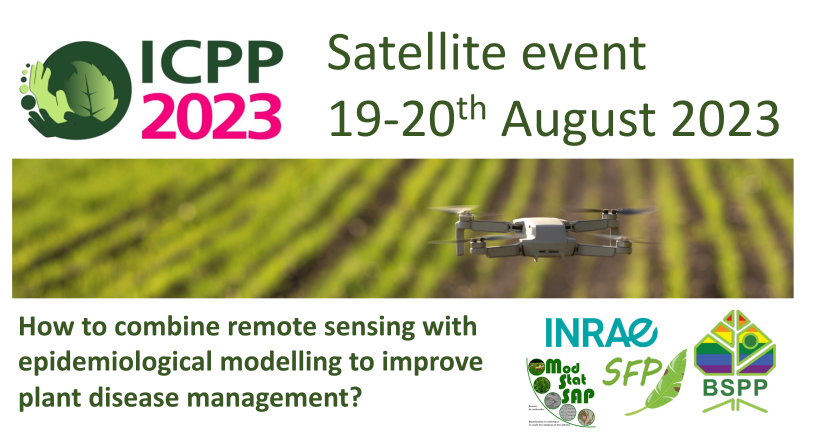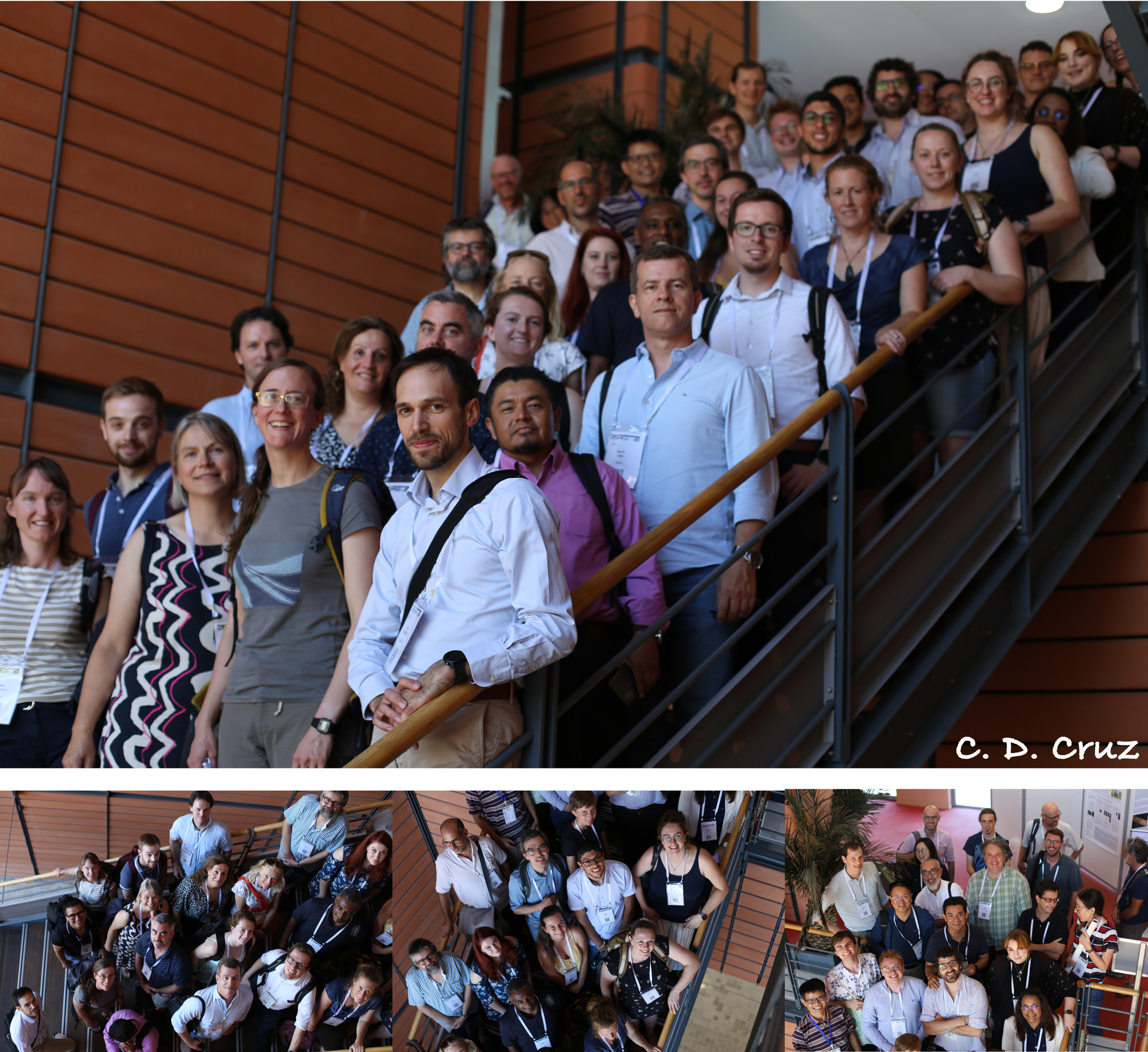
The Episense workshop was supported by ModStatSAP and co-organised by INRAE members of the network. It was integrated into satellites meeting which preceded the 12th International Congress of Plant Pathology in Lyon, France from August 20-25, 2023.
Organising committee. Alexey Mikaberidze (University of Reading, UK), Carlos Camino (EC JRC, Italy), Frédéric Fabre (INRAE, France), Frédéric Hamelin (Institut Agro, France), Nik Cunniffe (University of Cambridge, UK), Pieter Beck (EC JRC, Italy), Stephen Parnell (University of Warwick, UK) and Suzanne Touzeau (INRAE, France).
Scope and aims.
Recent technological advances suggest that plant diseases can be detected early – at various spatial scales – using remote sensing. This offers the possibility of revolutionising our understanding of plant pathogen interactions. Remote sensing is a rapidly growing research field. There is also a large existing research community focused on plant disease epidemiology and modelling. However, and with some notable exceptions, few researchers concentrate on using remote sensing for plant diseases.
This satellite meeting intended to link two – currently largely disjoint – research communities. We have aimed to bring together plant disease modellers and those interested in remote sensing. Our schedule contained some talks very firmly on one topic or the other, as well as some explicitly on the interface.
As well as linking the two communities, a goal of the meeting is to write a “Challenges in…” review article, highlighting what progress has been made, and what remains to be done. A group that emerged during the meeting wrote an article which has now been published in Phytopathology:
Program.
Book of program and abstract (download here)
Day One. Saturday 19th August 2023
SESSION ONE. INTRODUCTION & DIDACTIC TALKS (11am – 12.30pm) [Rapporteur = Frédéric Fabre]
10h30 Welcome and coffee break
11h00 The organisers
11h05 Didactic talk by A. Mikaberidze and N. Cunniffe “Epidemiological modelling and the Basic Reproduction Number, R0”
11h45 Didactic talk by U. Rascher “Measuring plant structure and function using optical remote sensing – current status and recent advantages of airborne and satellite remote sensing and their potential for disease detection”
12h30 Lunch
SESSION TWO. KEYNOTE TALKS (1.30pm – 5.15pm) [Rapporteur = Suzanne Touzeau]
13h30 Invited talk by K. Gold “Harnessing remote sensing & imaging spectroscopy for scalable solutions in agricultural disease management: a novel framework for risk prediction”
14h15 Invited talk by S. Soubeyrand “Estimating Beet Yellows severity at plot resolution with satellite observations”
15h10 Flash talk for posters
15h50 The organisers “Brief introduction to review article: challenges in combining remote sensing with epidemiological modelling”
16h30 Invited talk by P. Zarco-Tejada “High-resolution hyperspectral and thermal imaging for the early detection of plant diseases. Prospects and limitations”
17h30 Poster session
Day Two. Sunday 20th August 2023
SESSION THREE. CONTRIBUTED TALKS (9.30am – 12.30pm) [Rapporteur = Frédéric Hamelin]
9h30 S. Fraser “Combining remote sensing and epidemiological modelling to improve management of red needle cast of Radiata Pine in New Zealand”
9h50 . V. Rossi “Can remote sensing data improve mathematical models for tactical decision making & fungicide application?”
10h10 R. Calderon “Mapping global risk of fusarium wilt in a changing climate with remote sensing and aerosol transport modelling”
11h00 M. McMenemy “An epidemiological model to assess the efficacy of monitoring technologies for early detection of tree pests and pathogens at local & treescape levels”
11h20 M. Günder “Combining data and knowledge for disease spread modelling and simulation shown for Cercospora leaf spot in sugar beet”
11h40 C. Cruz “Integrating UAS-based multispectral imaging and epidemiological modelling in cereal crops”
12h00 M. Leclerc “Combining imaging and spatially explicit modelling for the study of plant diseases: lessons learned from the study of plant pathogen lesions”
12h10 R.Darvishzadeh “Understanding fall armyworm infestation in maize fields of Bangladesh using temporal Sentinel-2 data”
SESSION FOUR. FURTHER CONTRIBUTED TALKS & DISCUSSION OF REVIEW ARTICLE– 5.30pm) [Rapporteur = Stephen Parnell]
13h30 J. Ellis “A modelling approach to map the risk of HLB in the Iberian Peninsula”
13h45 R. Campbell “Disease climatic risk model interpretations at multiple spatial scales”
14h00 D. Lee “The utility of proximal sensing and deep learning in the detection and characterization of Tar Spot epidemics on corn in the United States”
14h15 R. Trimble “Integrating reinforcement learning & epidemiological models for control optimisation with limited information”
14h30 C. Camino “Quantifying Vcmax & plant traits to monitor forest decline by satellite images & biophysical models”
14h45 S. Delalieux “Remote sensing in support of plant disease detection at different spatial scales”
15h10 The organisers “Brief synthesis of all sessions & orientation for breakout sessions”
17h00 The organisers “Further discussion of review article, and selection of section lead authors”

Funding acknowledgments. This satellite event would not have been possible without generous funding provided by BSPP (British Society for Plant Pathology), SFP (Société Française de Phytopathologie), INRAE (Plant Heath & Environment division, Mathematics & Digital Technologies division and ModStatSAP, the research network in Modelling and Statistics for Animal and Crop Health).